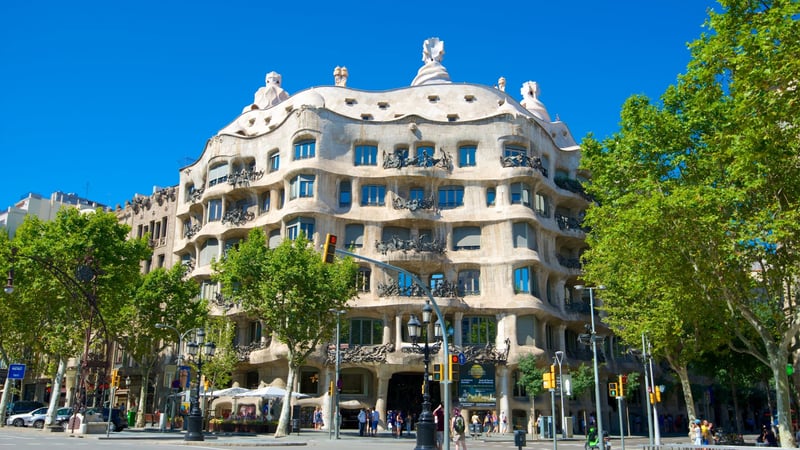İçindekiler
Located on the famous Passeig de Gràcia in Barcelona’s Eixample district, Casa Milà is one of the most remarkable buildings in the city. This extraordinary building is much more than an ordinary apartment building. Antoni Gaudí’s original design is a work that pushes the boundaries of architecture. Let’s explore the story of this important example of modernist architecture
Story of Casa Milà
The story of Casa Milà begins in 1906. Pere Milà and his wife Roser Segimon, one of the rich bourgeois of Barcelona at the time, wanted to build a new house in Passeig de Gràcia. They chose Antoni Gaudí, the most famous architect of the time, a decision that would change the skyline of Barcelona forever.
Why “La Pedrera”?
Casa Milà is also popularly known as “La Pedrera” (The Quarry). This nickname comes from the building’s undulating stone facade. During construction, Barcelonans compared this unusual building to a quarry. Initially a subject of ridicule, this nickname turned into an affectionate name over time.

Gaudí’s Vision: Reflection of Nature on Architecture
Casa Milà is the pinnacle of Gaudí’s nature-inspired design. The undulating facade of the building looks as if it was shaped by the wind. Gaudí did not want to use anything artificial, he designed everything according to the forms of nature.
Functionality and Aesthetics in Indoor and Outdoor Spaces
Casa Milà’s interiors are as impressive as its exteriors. Gaudí designed every detail with care. For example, the interior courtyards not only provide light and air circulation, but are also works of art. Colorful murals and carved stonework transport visitors to a fairytale world. For me, the roof terrace of Casa Milà is the most impressive part of the building. The chimneys and ventilation shafts have become sculptures in Gaudí’s hands. Sometimes these figures resemble a warrior, sometimes an animal. The views of Barcelona from the terrace are breathtaking.

Casa Milà’s Challenging Years and Rebirth
The story of Casa Milà did not always go smoothly. During its construction, there were frequent disagreements between Pere Milà and Gaudí. At one point Gaudí even considered abandoning the project.
Civil War and Aftermath: During the Spanish Civil War, the building was damaged and fell into disrepair for many years. In 1984, with its inscription on the UNESCO World Heritage List, Casa Milà’s fate changed. Extensive restoration work was initiated and the building was restored to its former splendor.
Today Casa Milà: A Living Museum
Today Casa Milà is both a museum and a living apartment building. The upper floors are still privately owned, while the lower floors and the roof terrace are open to visitors. Visiting Casa Milà is like time travel. The tours, supported by visual shows, offer a deep insight into Gaudí’s world. The night tours in particular offer an unforgettable experience with the dramatic lighting of the sculptures on the roof terrace.

Discover Casa Milà
I have a few suggestions for those who want to visit Casa Milà. First of all, I recommend you to buy your tickets in advance. Especially in the summer months, there can be long queues. Make sure to take advantage of the audioguide service. Learning the details and stories in every corner of the building will enrich your experience.
Casa Batlló is certainly less remarkable compared to its popularity, but if you are planning to visit Barcelona, be sure to add this building to your sightseeing list.
Casa Milà
Website
https://lapedrera.com/en
Visiting Hours
Weekdays: 09:00 / 23:00
Weekends: 09:00 / 23:00
Address
Pg. de Gràcia, 92, L’Eixample, 08008 Barcelona








